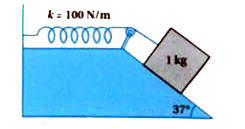(a) Give reason why transverse waves can be propagated in solids,
(b) Give reason why longitudinal waves can be propagated through all the three types of media - solids, liquids and gases.
(c) Describe in brief about two types of waves that can be propagated on the free surface of water.Solution in Gujrati
(a) In order to have propagation of transverse waves, we need to produce crests and troughs. Tor this we need to produce shearing strain whereby we can change the shape of a medium. For this to happen, medium selected for the propagation of transverse waves, must be capable enough to sustain shearing stress i.e. They must have very high value of modulus of rigidity. Now we know that solids have very high value of modulus of rigidity. Hence transverse waves can be propagated in solids.
(b) Longitudinal waves propagate in the form of condensations and rarefactions, causing changes in density and pressure. Accordingly, compressive and expansive stresses are produced. All the three media - solids, liquids and gases can sustain compressive and expansive stresses and so longitudinal waves can be propagated in all of these media.
(c) Two types of waves which can propagate on free surface of water (i.e, on the uppermost layer of water which is in contact with atmosphere) are capillary waves and gravity waves.
(i) Capillary waves : They are transverse waves of fairly short wavelengths (few centimeter only). Here necessary restoring force is produced due to surface tension property of water.
(ii) Gravity waves : They are transverse as well as longitudinal in nature. They have large wave lengths ranging from several meters to several hundred meters. Here necessary restoring force is produced by the pull of gravity, which compels water surface to remain at lowest possible level. During the propagation of these waves on the free surface of water all the particles of water medium, from surface to the bottom oscillate with gradually decreasing amplitude Here particles of water medium oscillate up and down as well as back and forth. The waves in an ocean are the combination (superposition) of transverse and longitudinal waves.
Transverse and longitudinal waves are found to be travelling with different speeds even in the same solid medium (because for a given solid medium, its shear modulus and bulk modulus are different.)
Topper's Solved these Questions
- WAVESBOOK - KUMAR PRAKASHANCHAPTER - WAVESEXERCISE - SECTION-A TRY YOUR SELF
63 Videos
- WAVESBOOK - KUMAR PRAKASHANCHAPTER - WAVESEXERCISE - SECTION-B (Numericals) (Numerical From Textual Illustrations)
14 Videos
- UNITS AND MEASUREMENTBOOK - KUMAR PRAKASHANCHAPTER - UNITS AND MEASUREMENTEXERCISE - Section -F (Questions from Module )
20 Videos
- WORK, ENERGY AND POWER BOOK - KUMAR PRAKASHANCHAPTER - WORK, ENERGY AND POWER EXERCISE - QUESTION PAPER (SECTION - D)
1 Videos
Similar Questions
What are called waves ? Mention their importance.
View SolutionGiven below are some examples of wave motion. State in each case if the wave motion is transverse, longitudinal or a combination of both:
(a) Motion of a kink in a longitudinal spring produced by displacing one end of the spring sideways.
(b) Waves produced in a cylinder containing a liquid by moving its piston back and forth.
(c ) Waves produced by a motorboat sailing in water.
(d) Ultrasonic waves in air produced by a vibrating quartz crystal.
View SolutionIf the error in measurement of radius of a shpere is 2% then the error in determination of volume of the sphere will be …………
View SolutionA 1 kg block situated on a rough incline is connected to a spring constant 100Nm−1 as shown in figure . The block is released from rest with the spring in the unstretched position . The block moves 10 cm down the incline before coming to rest . Find the coefficient of friction between the block and the incline .Assume that the spring has a negligible mass and the pulley is frictionless.

View SolutionAssertion : Solids can support both longitudinal and transverse waves but only longitudinal waves can propagate in gases.
Reason : For the propagation of transverse waves, medium must also necessarily have the property of rigidity.
View SolutionThe type of waves that can be propagated through solid is
View SolutionThe transverse waves can propagate through
View SolutionWhy transverse mechanical waves can not be propagated in liquids and gases?
View SolutionWhich of the following statements are true for wave motion? Statement 1- Mechanical transverse waves can propagate through all media Statement 2- Longitudinal waves can propagate through solids only Statement 3- Mechanical transverse waves can propagate through solids only Statement 4- Longitudinal waves can propagate through vacuum.
View SolutionThrough what type of media can transverse waves be transmitted? Give reason
View SolutionThrough what type of media can longitudinal waves be transmitted? Give reason
View SolutionThe type of waves that can be propagated through solid is
View Solution(A): Mechanical transverse waves can propagate only in medium with shear inodulus of elasticity (B) : Longitudinal waves need bulk modulus of elasticity and are therefore. Possible in all media, solids, liquids and gases
View Solution(A): Solids can support both longitudinal and transverse waves but only mechanical longitudinal waves can propagate in gases. (R): For the propagation of mechanical transverse waves, medium must also necessarily have the property of rigidity.
View SolutionWhich of the following statements are true wave motion? a) Mechanical transverse waves can propagate through all mediums. b) Longitudinal waves can propagate through solids only c) Mechanical transverse waves can propagate through only d) Longitudinal waves can propagate through vacuum.
View Solution
